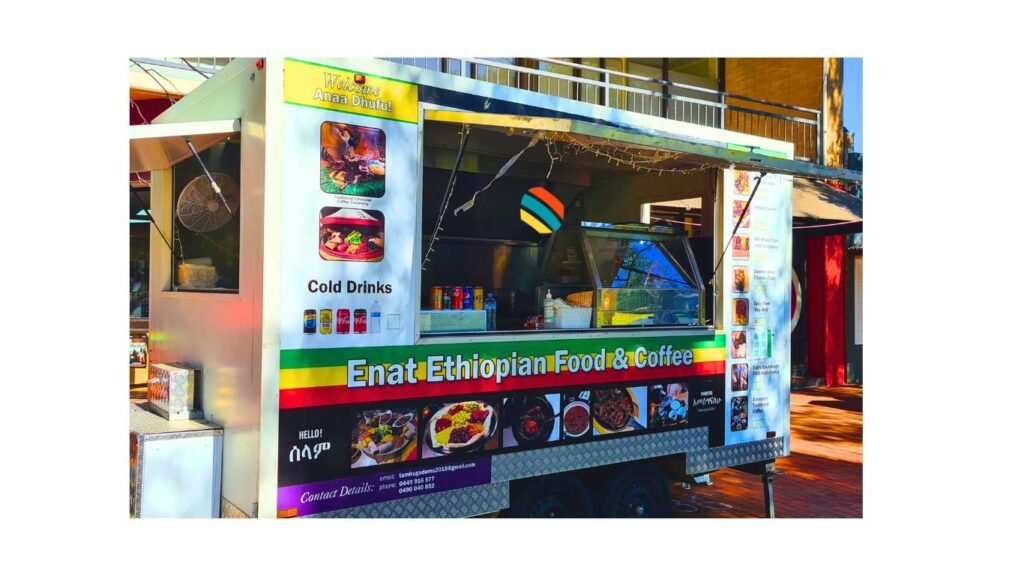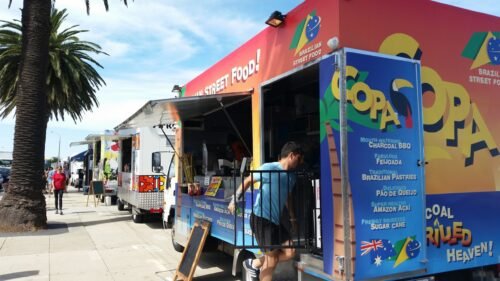How to start a food truck business in Australia
Did you attend a music festival and admired the large number of people lining up to buy from food trucks? Or did a beautifully designed food truck pass by your hood, and you were like: “What the heck is that beautiful thing?” You aren’t alone. Food trucks are meant to have that first impression. Their owners love them, and the community love them too. But is that enough to make you start one? It shouldn’t.
But whom do you turn to to get accurate advice? Many food truck articles found online are academic. Just Google, and you will find lots of them written by consultancy firms, web hosting companies, loan firms, bloggers, etc., none of whom has ever operated a food truck business. How can you write about travel, for example, when you have never left your village to go to the next town? Anyway, this is the internet age, and anyone can write what they want online.
In this post, I will walk you through the step-by-step process of starting a food truck business. I have been there and done that, and you can, too. Why not? Here we go.
Step 1: Take some time to work in a busy food truck kitchen
Yes, you heard me, didn’t you? Don’t play dumb, and be lazy! Nothing comes easy. You need practical experience. As kitchen hand, cook, chef, customer relations / front office, social media influencer, website manager, lifting, managing the cash drawer / till, bookkeeping, cleaning (loads of it, unfortunately), driving, etc. Anything you can lay your hands on. Don’t’ tell your Kitchen Supervisor: “that is not my job” Be willing to learn, irrespective of your background.
And this is why: first, to develop practical skills in commercial kitchen operations, and second, to determine whether it is something you will like doing.
Only if you have completed at least one to two years’ work in a food truck should you decide whether food truckin’ is for you.
Of course, we have people who have worked in big commercial kitchens. In that case, you need to jump to step 2. So that you know, food trucks are different – often working in constrained spaces.
Step 2: Conduct market research about Food Trucks
While working in a commercial kitchen, you will collect practical and vital data about food trucks, kitchen operations, equipment costs, menu planning, inventory management, local Council licenses and the best locations to set up. Your research will answer some of the following questions:
- What is the gap in the market, and how do you plan to fill that gap? For example, before I started, I researched and found out there were no African food vans in Australia. My plan was to enter into that niche.
- Who will your potential customers be? What do they like and why? Where do they live? Which places do they frequent? What is their purchasing power? To be honest not everyone is going to afford gourmet street food. People living in poorer cities and surviving on Centrelink income can hardly afford gourmet meals of between $15 to 30 per serving.
- What is the cost of setting up a food truck? This varies and depends on whether you want to use a food trailer, marque or large commercial food truck. Also, if you lease or buy a second-hand truck and kitchen equipment, which I recommend save for mechanical issues, you might save loads.
- Who will be your potential suppliers of food truck, kitchen equipment, cooking utensils, generator etc?
- What are the best locations to vend? Again, this depends on your commercial location and type of food. If, for example, you live in Brimbank, Victoria, and plan to sell ordinary sausages and chips, you may not be attractive to clients who live in South Melbourne. These clients may prefer healthy, ethnic food but pay slightly more .
- Who are the existing food truck operators, and where do they usually go? Food trucks perform best in groups, especially during festivals and big events, as they provide a variety to attendees. You want to be near your colleagues who will advocate for your needs, share space, mobile cool rooms, power, and support you on social media.
- What licenses do I need to commence operations? Who issues them, and what are the requirements?
- Who are the existing event organisers? Are the events lucrative? Before you start you must research and develop relationships with existing markets and event organisers and attend events where food trucks frequent. For example, if they are at the St Kilda Festival, visit, taste the food, look at the setup, speak to vendors, and take photos.
At this stage, your idea is only known to you and close family members or friends. Please keep it private, for someone might steal the idea and set it up before you do. Not even your bosses at work should know you are planning to set up another operation – they might not like it and think you are there to steal company secrets.
Step 3: Come up with a Business Name
At this stage, you should develop some swanky name you think your clients will love. Usually, the business name should be easy and straightforward for people to remember. It must also align with or tell the story of the products and services you will provide.
If you are a South African national planning to vend Bunny Chow in Melbourne, don’t christen your food truck “Johnny Loves Italian Food.”
I recommend a business name that is:
- easy for clients to remember;
- short and,
- dissimilar to existing business names (unique) to avoid confusion in the marketplace.
Don’t steal another person’s business name, even if they live in the United States. Also, try to avoid trademarked names, whether locally or overseas. You don’t want to spend time building a business only to be hit with a hefty lawsuit or deletion of your account.
Step 4: Check whether the Domain Name is Available
You need a domain name that matches your business name. If you come up with the name “WhiteGuyCooksThai,” you should check that it is available. You can use any internet hosting company like Go Daddy or Hostinger to check and reserve a domain name.
Also, decide whether you want the .com, .com.au or .au domain. If you find that a .com domain is not yet reserved but plan to expand your business in future, then reserve both the Australian domain name and the .com domain name.
When I reserved the AFROFEAST domain name in 2013, I left out www.afrofeast.com, which was available, and only reserved afrofeast.travel. Years later, when I tried to reserve the .com name, an African living in the UK who had known about my business through Facebook (only Facebook was popular then), had reserved the .com domain. So, be pragmatic and think long-term when starting up.
Step 5: Check whether the Business Name is Available on Social Media
This is important. Before reserving your domain name, you must check whether they are available on all major social media platforms.
In 2013, I remember checking all major social media handles before reserving my domain name. These included:
- Facebook. www.facebook.com/afrofeast (lost access, now using www.facebook.com/afrofeast1)
- Youtube
- Vimeo
Over the years, after we popularised the name AFROFEAST, certain individuals from South Africa, the UK, the United States, Britain, Canada and even Australia imitated the name and registered it on social media.
However, as you might know, big social media companies like Pinterest, TikTok and Meta try to avoid counterfeiting names on their platforms. They may delete your account for trademark infringement at any time. So, be sure to check a name that does not exist before registering.
Step 6: Register Your Business Name
After choosing a unique business name, register it. Contrary to existing belief, you don’t need to be a registered company to register a business name. You can register a business name as:
- A sole proprietor with an ABN – an individual.
- Partnership – two or more people running a business.
- A private limited company or
- Any other legal entity.
Step 7: Register A Trademark
You must register a trademark to have exclusive rights in Australia.
I made the mistake of not registering AFROFEAST as a trademark until a Canadian person contacted me around 2019 to sell my social media handles to her. I declined and filed a registration immediately.
A trademark acts as insulation against infringers. Yes, if you have a trademark registered in Australia, you can enforce it globally on social media platforms without necessarily registering it in all jurisdictions. This is under what social media platforms call brand protection rights.
So, engage a lawyer to help you early in the process. You can also apply for trademark registration without involving a lawyer.
Step 8: Design and build the food truck
First, you need cash. For the truck. Kitchen. Generator. Licences. Web design and social media promotion. Truck design. Inventory. Equipment. Employees. Food truck signage. The list is long.
How much are we talking about here? 10,000 to 300,000, depending on whether you want a food cart, trailer or a big self-contained gourmet food truck. I briefly discuss the differences below.
- Food carts: I don’t categorise these as food trucks, but I will mention them anyway. Food carts should be less than 10,000. They are simple, manually operated two-wheeled vehicles used to sell simple items along the streets. In Australia, they are mainly found in markets such as Queen Victoria. In Asia, though, they are common and attached to the tuk-tuk. I recently saw several on Khaosan Road.

- Food trailers should generally cost between 15,000 to 35,000. Food trailers are ready-made commercial kitchens powered by a small generator. However, you must have another vehicle, usually 4WD, to tow them whenever you go. Food trailers are cheaper but challenging to move around and park, especially during food truck events, where you are usually allocated a 6X3 parking spot (just enough for your food truck and cool room). Event organisers tend to avoid them. Check out these food trailers; they look nice.

Enat Ethiopian Food & Coffee | Dennis Obel
- Self-contained food trucks cost over $150,000. They are fitted with water tanks, including hot water, drainage systems, stainless steel kitchens and generators. They mainly measure 3 m wide x 3.7m high x 4.5 m long.

Coppa Food Truck at the St Kilda Festival 2016 | Dennis Obel
You can also buy second-hand if you wish—or even lease. If you purchase a used food truck, you will spend less, between $50,000 and $80,000.
Second, you must design and build your food truck according to specific regulations and standards to minimise risks to the public. While planning my food van construction, I found this guide from the Queensland Health Department quite helpful.
However, if you buy a ready-made food van, the workshop will most likely construct it according to the required standards. However, you will still have to pay the extra costs.
At a minimum, your food truck must meet the following:
- Stainless steel around the cooking area
- Fridge (underneath the prep bench)
- Rangehood and exhaust fan
- Washing sink and hot water
- Proper waste drainage system
- Electrical works completed according to standard and a certificate
- Professional gas fitter and the Energy Safe Victoria certificate
- Fire safety and fire blanket
- Generator and proper smoke emission
- Non-slip floor and
- Public liability insurance.

Step 10. Apply for a trading license
Once you are ready, apply for a trading license. Your local Council will schedule an inspection and, if you pass, issue the permit. If they have issues, they will raise them with you until you fix them.
Just to let you know, your permit is issued on the premises where your food truck is registered. So, if you live in Eltham North, as I did, you must apply to Nilumbik Council to inspect your food truck and issue a permit.
If you want to vend in the City of Melbourne, you must apply to Melbourne City Council.
Any questions? Let me know in the comments below.
